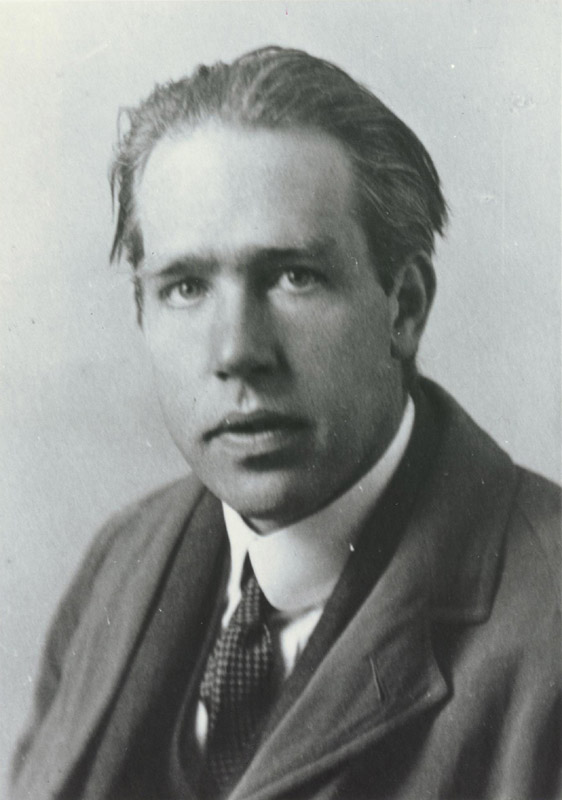
Niels Bohr
(1885 - 1962)
Niels Henrik David Bohr (October 7, 1885 - November 18, 1962) was a Danish physicist who made essential contributions to understanding atomic structure and quantum mechanics.
Bohr was born in Copenhagen in 1885. His father, Christian Bohr, was a professor of physiology at the University of Copenhagen, while his mother, Ellen Adler Bohr, came from a wealthy Sephardic Jewish family prominent in Danish banking and parliamentary circles. His brother was Harald Bohr, a mathematician and Olympic soccer player who played in the Danish national team; Niels Bohr was a passionate soccer player as well, but, contrary to what is claimed sometimes, never played in the national team.
Bohr received his doctorate from Copenhagen University in 1911. He then studied under Ernest Rutherford in the Victoria University of Manchester in England. Based on Rutherford's theories, Bohr published his model of atomic structure in 1913, introducing the theory of electrons traveling in orbits around the atom's nucleus, the chemical properties of the element being largely determined by the number of electrons in the outer orbits. Bohr also introduced the idea that an electron could drop from a higher-energy orbit to a lower one, emitting a photon (light quantum) of discrete energy. This became a basis for quantum theory.
Middle years
In 1916, Niels Bohr became a professor at the University of Copenhagen, and director of the newly constructed "Institute of Theoretical Physics" in 1920. In 1922, he was awarded the Nobel Prize in physics "for his services in the investigation of the structure of atoms and of the radiation emanating from them".
Bohr also conceived the principle of complementarity: that items could be separately analyzed as having several contradictory properties. For example, physicists currently conclude that light is both a wave and a stream of particles - two apparently mutually exclusive properties - based on this principle. Bohr also found philosophical applications for this daringly original principle. Albert Einstein much preferred the determinism of classical physics over the probabilistic new physics of Bohr (to which Max Planck and Einstein himself had contributed). He and Bohr had good-natured arguments over the verity of this principle throughout their lives. One of Bohr's most famous students was Werner Heisenberg, a crucial figure in the development of quantum mechanics, who was also head of the German atomic bomb project.
Niels Bohr and his wife Margrethe had six children. Two died young, and most of the others went on to lead successful lives. One, Aage Niels Bohr, also became a very successful physicist; like his father, he won a Nobel prize.
Later years / Death / Legacy
In 1941, during the German occupation of Denmark in World War II, Bohr was visited by Heisenberg in Copenhagen (see next section). In 1943, shortly before he was to be arrested by the German police, Bohr escaped to Sweden, and then travelled to London.
He worked at the secret Los Alamos laboratory in New Mexico, USA, on the Manhattan Project, where, according to Richard Feynman, he was known by the assumed name of Nicholas Baker for security reasons. However his role in the project was minor. He was seen as a knowledgeable consultant or "father confessor" on the project. He was concerned about a nuclear arms race, and is quoted as saying "That is why I went to America. They didn't need my help in making the atom bomb."
Bohr believed atomic secrets should be shared by the international scientific community. After meeting with Bohr, J. Robert Oppenheimer suggested Bohr visit President Franklin Roosevelt to convince him that the Manhattan Project should be shared with the Russians in the hope of speeding up its results. Roosevelt suggested Bohr return to England to try to win British approval. Churchill opposed the idea.
After the war he returned to Copenhagen, advocating the peaceful use of nuclear energy. He died in Copenhagen in 1962. He is buried in the Assistens Kirkegård in the Nørrebro section of Copenhagen.
The element bohrium is named in his honor.
Relationship with Heisenberg
Werner Heisenberg claimed in an interview after the war, when the author Robert Jungk was working on the book Brighter Than a Thousand Suns, that he had tried to establish a pact with Bohr such that scientists on neither side should help develop the atomic bomb. He also said that the German attempts were entirely focused on energy production, and that his circle of colleagues tried to keep it that way. Heisenberg nuanced his claims, though, and avoided implication that he and his colleagues had purposely sabotaged the bomb effort. However, this nuance was lost in Jungk's original publication of the book, which strongly implied that the German atomic bomb project was rendered purposely stillborn by Heisenberg.
When Bohr saw this depiction in the Danish translation of Jungk's book, he disagreed wholeheartedly. He said that Heisenberg had indeed let him know in Copenhagen that he was working on an atomic bomb project, and that he thought that Germany would win the war. He dismissed the idea of any pact as an after-the-fact construction. He drafted several letters to inform Heisenberg about this but never sent any of them.
Michael Frayn's play Copenhagen, which ran on Broadway for a time, explores what might have happened at the 1941 meeting between Heisenberg and Bohr. The truth of the historical event is still a matter of scholarly debate, as neither Bohr nor Heisenberg spoke about it in any detail, and they were alone in the woods.
Courtesy of:
